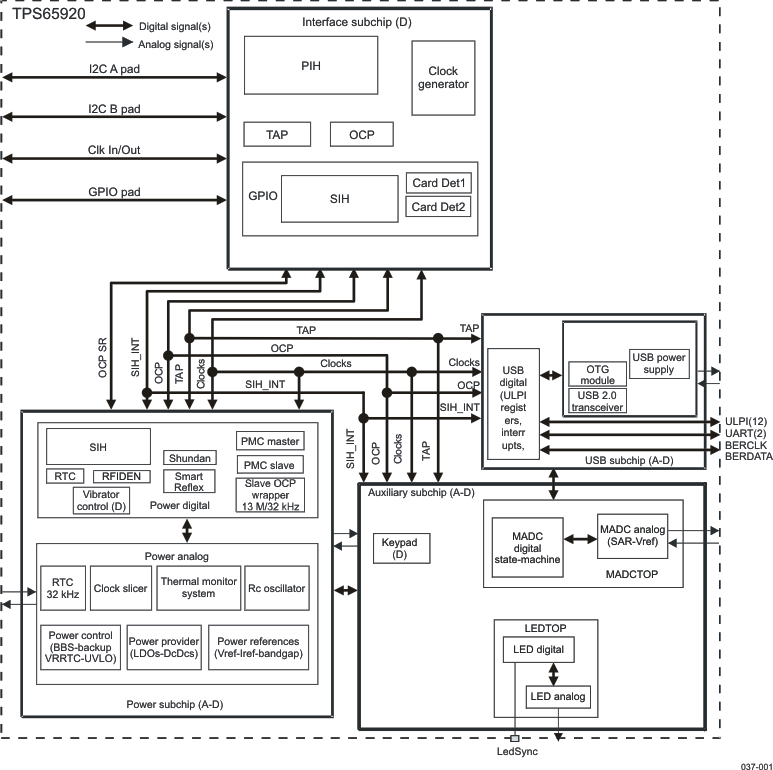SWCS037I May 2008 – January 2015 TPS65920 , TPS65930
PRODUCTION DATA.
- 1Device Overview
- 2Revision History
- 3Terminal Configuration and Functions
- 4Specifications
-
5Detailed Description
- 5.1
Power Module
- 5.1.1 Power Providers
- 5.1.2 Power References
- 5.1.3 Power Control
- 5.1.4 Power Consumption
- 5.1.5 Power Management
- 5.2 Real-Time Clock and Embedded Power Controller
- 5.3 USB Transceiver
- 5.4 MADC
- 5.5 LED Drivers
- 5.6 Keyboard
- 5.7 Clock Specifications
- 5.8 Debouncing Time
- 5.9 External Components
- 5.1
Power Module
-
6Audio/Voice Module (TPS65930 Device Only)
- 6.1 Audio/Voice Downlink (RX) Module
- 6.2 Audio Uplink (TX) Module
- 7Device and Documentation Support
- 8Mechanical, Packaging, and Orderable Information
Package Options
Mechanical Data (Package|Pins)
- ZCH|139
Thermal pad, mechanical data (Package|Pins)
Orderable Information
1 Device Overview
1.1 Features
-
Power:
- Three Efficient Step-down Converters
- Four External Linear LDOs for Clocks and Peripherals
- SmartReflex™ Dynamic Voltage Management
- Audio (TPS65930 Device Only):
- Differential Input Main Microphones
- Mono Auxiliary/FM Input
- External Predrivers for Class D (Stereo)
- TDM Interface
- Automatic Level Control (ALC)
- Digital and Analog Mixing
- 16-Bit Linear Audio Stereo DAC (96, 48, 44.1, and 32 kHz and Derivatives)
- 16-Bit Linear Audio Stereo ADC (48, 44.1, and 32 kHz and Derivatives)
- Carkit
- USB:
- USB 2.0 On-the-Go (OTG)-Compliant HS Transceivers
- 12-Bit Universal Transceiver Macro Interface ULPI
- USB Power Supply (5-V Charge Pump for VBUS)
- Consumer Electronics Association (CEA)-2011: OTG Transceiver Interface Specification
- CEA-936A: Mini-USB Analog Carkit Specification
- Additional Features:
- LED Driver Circuit for Two External LEDs
- Two External 10-Bit MADC Inputs
- Real-Time Clock (RTC) and Retention Modules
- HS I2C Serial Control
- Thermal Shutdown and Hot-Die Detection
- Keypad Interface (up to 6 × 6)
- External Vibrator Control
- 15 GPIOs
- 0.65-mm Pitch, 139-Pin, 10-mm × 10-mm Package
- Charger:
- Backup Battery Charger
1.2 Applications
- Smart Phones
- Tablets
- Industrial
- Handheld Systems
1.3 Description
The TPS65920 and TPS65930 devices are power-management ICs for OMAP™ and other mobile applications. The devices include power-management, a universal serial bus (USB) high-speed (HS) transceiver, light-emitting diode (LED) drivers, an analog-to-digital converter (ADC), a real-time clock (RTC), and an embedded power control (EPC). In addition, the TPS65930 includes a full audio codec with two digital-to-analog converters (DACs) and two ADCs to implement dual voice channels, and a stereo downlink channel that can play all standard audio sample rates through a multiple format inter-integrated sound (I2S)/time division multiplexing (TDM) interface.
These optimized devices support the power and peripheral requirements of the OMAP application processors. The power portion of the devices contains three buck converters, two controllable by a dedicated SmartReflex class-3 interface, multiple low dropout (LDO) regulators, an EPC to manage the power sequencing requirements of OMAP, and an RTC and backup module. The RTC can be powered by a backup battery when the main supply is not present, and the devices include a coin-cell charger to recharge the backup battery as needed.
The USB module provides a HS 2.0 OTG transceiver suitable for direct connection to the OMAP UTMI+ low pin interface (ULPI), with an integrated charge pump and full support for the carkit CEA-936A specification. An ADC is provided for monitoring signals, such as supply voltage, entering the device, and two additional external ADC inputs are provided for system use.
The devices provide driver circuitry to power two LED circuits that can illuminate a panel or provide user indicators. The drivers also provide pulse width modulation (PWM) circuits to control the illumination levels of the LEDs. A keypad interface implements a built-in scanning algorithm to decode hardware-based key presses and reduce software use, with multiple additional general-purpose input/output devices (GPIOs) that can be used as interrupts when configured as inputs.
1.4 Functional Block Diagram
Figure 1-1 shows the TPS65920 device block diagram.
 Figure 1-1 TPS65920 Block Diagram
Figure 1-1 TPS65920 Block Diagram